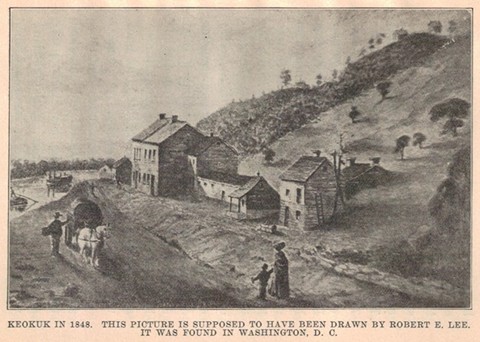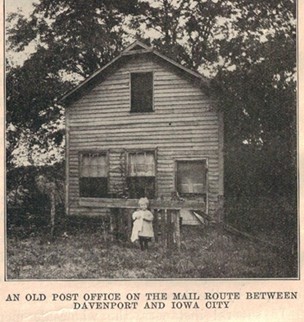XVI.
SOME EARLY NEWSPAPERS pgs 142-153
To-day every one expects to have a morning or an evening paper and sometimes both. It is not easy for us to think of a time when there were no dailies; but for the earliest settlers there were no Iowa papers at all. And because there were no telegraph or telephone lines news traveled very slowly. Since eastern Iowa was settled first, naturally the first newspaper appeared in that part of the Territory. As the people kept settling westward newspapers became more numerous. All of the settlements have some history of their first papers and in them are found many interesting things. A few of these papers may be mentioned.
The first one was published at the settlement about the lead mines near Dubuque, Wisconsin Territory, as the heading of the paper shows, in 1836. It was called The Visitor and the editor was Mr. John King. His printing outfit was brought from Cincinnati, probably by way of the Ohio and the Mississippi Rivers. The motto of that paper, the first one in the country west of the Mississippi and north of the Missouri, is worth remembering, for it read: �Truth our Guide�the Public Good our Aim�. In the first number of The Visitor there was an article on the country surrounding Dubuque, one about �Good Housewives�, and another which advised the division of the Territory of Michigan.
After some severe trials, a change of owners, and finally a change in name to The Iowa News, this first paper was given up in 1842. A copy of The Iowa News may be found in the public library at Dubuque. It is dated at the Upper Mississippi Lead Mines, Iowa Territory, Saturday, August 11, 1838. Before 1842, however, the Miners' Express (at Dubuque) had been begun, and by 1844 there was another paper, called the Iowa Transcript. In 1848 one called the Democratic Telegraph sent out its first issue, and the material with which it was printed was afterward (in 1853) sent to Fairfield, Iowa, where the Fairfield Ledger, one of the oldest papers in Iowa, was then established. The Dubuque Herald, first printed about 1851, was soon afterward united with the Miners' Express.
It was about a year after the first appearance of The Visitor at the Dubuque Lead Mines that the first paper at Burlington�the Territorial Gazette and Burlington Advertiser�was published. James Clarke, afterwards the Governor of the Territory, was the publisher; and it seems that he printed the first paper at Belmont, the capital of Wisconsin Territory, before it was moved to Burlington. So it may be said that his paper was begun at Belmont in 1836, and was moved to Burlington in 1837. After Iowa became a State in 1846, the name was changed to the Iowa State Gazette.
Before 1838 Dr. Isaac Galland had published the Western Adventurer at Montrose (in Lee County), one of the oldest towns in Iowa. It happened that the printing material which he used was later taken to Fort Madison to print the Patriot, which had been begun by Mr. James G. Edwards, a well-known editor. The Patriot at Ford Madison did not continue very long, but the name was used again, in 1839, at Burlington where Mr. Edwards started the Iowa Patriot. Very soon afterward he gave it the name of the Hawk-Eye and Iowa Patriot. This name was thought very suitable, since the Iowa people were to be called Hawkeyes�a name which, it is said, was first suggested by Mr. Edwards while he was in Fort Madison. Out of these several names has come the Burlington Hawkeye�a paper known throughout the country.
The Iowa Standard was first printed at Bloomington (Muscatine) in 1840; but the next year it was taken to Iowa City, the new capital of the Territory. This paper, and the Iowa Capitol Reporter, were newspapers which contained the local news at the capital of the Territory. When the people were trying to adopt a constitution for the new State, there was much in these two journals about it and the way to conduct a state government. In 1846 the entire constitution was published in these papers. About that time also the newspapers took considerable care to publish the names of banks from which the money, that is to say paper which they issued as money, could be regarded as good. And when the school law of 1847, the first under the Constitution of 1846, was passed, there were editorials on education and the care of the school lands.
About a week after the first number of the Iowa Standard the Bloomington Herald appeared. For nearly ten years it kept that name until in 1850, or near that time, it was changed to the Muscatine Journal (the name Bloomington was changed to Muscatine in 1849).
The Iowa Sun and the Davenport and Rock Island News was the very long name given to the first paper printed in Davenport. It seems to have lived for at least four years even with its long title. In 1841 the Davenport Gazette was begun; and the same year there was printed the Fort Madison Courier, the paper which later became the Fort Madison Plain Dealer. Names were changed so often that it is not an easy thing to keep account of all of them.
The Iowa Argus and Lee county Advertiser was another paper with a name almost as long as the one at Davenport. It was published for only a few months at Keokuk. It seems to have been the wish of the editors of some papers to have a name that would take in the whole of Iowa, and at the same time to have it belong especially to the county or town in which it was printed. In 1847 the Keokuk Register was started with only three subscribers; but so worthy were the editors that within a short time it had fully eighteen hundred. In 1849 the Des Moines Valley Whig, which had been published at Keosauqua from 1846, was united with the Keokuk Register, and these two, it seems, were the beginning of the Keokuk Gate City, a name which has been well known in Iowa since 1855.
In 1848 the Frontier Guardian was published at Kanesville, a name give to a settlement where the city of Council Bluffs is now built. The paper was edited by the leader of the Mormons who had stopped in western Iowa after they had been driven out of Illinois. Later they moved on to Utah and the Frontier Guardian was no longer published. It had been supported to defend the teachings of these people and there would have been no place for it after their departure. They are remembered in Iowa not only by the fact that they remained for sometime on the Missouri River, but also by the so-called Mormon Trail across the State in the southern part.
Names may show the political party to which a paper belongs, as the Des Moines Valley Whig, just mentioned. Or they may point out the location of the place where they happened to be published, as, for example, the Keokuk Gate City; for Keokuk is in fact at one of the gates to Iowa. Why the first paper at Fort Des Moines was called The Star is not quite clear unless, indeed, it was to point the way to the coming settlers in this new State. It was printed in the soldiers' barracks in 1849 at the fort where the city of Des Moines is now, the printing outfit having been brought across the country from the eastern part of the State.





